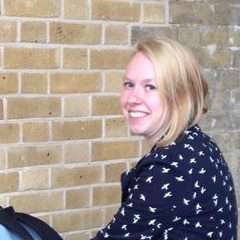Listening to music with your eyes: it is possible with Stephen Malinowski’s Music Animation Machine (MAM). This device shows the pitch, timing and duration of notes through symbols on a screen. Violinist Etienne Abelin used the machine and other ways of presentation to bring classical music closer to the audience of The Royal Concertgebouw. But does it work?
The auditorium is completely dark. Then suddenly the first notes of Bach’s Dolce from his Second sonata in A, BWV1015 sound. Nothing can be seen, not even the musicians, who cannot see their sheet music. The darkness makes the music piercing. When the musicians continue with the Andante, the lights come on, and the projection screen is enlightened. As Etienne Abelin and pianist Tamar Halperin play, the MAM shows the bass line on the screen in a steady pattern of dots. Above that, the two voices appear that together make this piece. The music becomes visible; even more in the subsequent Arabesque no. 1 (Debussy), performed with lovely variety in tempo and dynamics by Halperin. Through the different colours of symbolic patterns and the height of the symbols, one can clearly distinguish between the three, sometimes four different voices within the piano part. What an advanced device this MAM is.
But there is a disadvantage to this skilled machine. The idea is that music can be fathomed better with visuals. But the risk of the MAM is that one focuses completely on the colourful symbols on the screen without paying attention to the interpretation and performance of the music. Therefore it is good to have a bit of alternation between music with visuals and without visuals. Cellist Anita Leuzinger, for example, starts playing Bach’s Prelude from his Cello Suite no. 1 in G major, BWV1007 accompanied by pretty visuals. But there are no visuals with the Allemande and the Courante. Instead, one can enjoy Leuzinger completely lose herself in the music with her eyes closed.
In addition to visuals, Abelin’s company has another way of drawing classical music closer to the present. Electronic artist Tomek Kolczynski mixes up Bach’s Adagio from his Sonata for violin and keyboard no. 1 in B minor, BWV1014 with electronic sounds in what is called BachSpace I. The result of this tinkering is a cracking, noisy blend of space sounds without any sort of melody whatsoever. Kolczynski seems to have a different perception of aesthetics. But he surprises in the second half of the programme with BachSpace II. This is Bach with a beat and fun sound effects. Suddenly one can imagine dancing to this music; dancing to Bach - in a club.
Other works on the programme include Maurice Ravel’s Lent from his Sonata for violin and cello and Arvo Pärt’s Spiegel im Spiegel. Listening to the latter work in an almost dark room but with the patterns from the MAM as shining stars is enchantingly meditative. But it is in Johannes Brahms’ Andante con moto from his Piano trio no. 2 in C major, Op.87 that the ensemble sounds at their best: complete and firm.
But the highlight of this concert is not Brahms’ piece, nor the MAM with enlightening but distracting visuals. It is not Kolczynski’s remix of Bach’s music. It is Halperin’s composition Baustelle, which she based on Bach’s Tempo di Minuetto from the Partita no. 5 in G major, BWV829. With humorous accents and unexpected jazz cadences, Halperin gives a perfectly fresh interpretation of Bach’s work. This is the real blending of the past and the present: with feeling, melody and humour.


